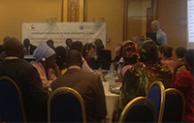Creating Demand for Life-Saving Commodities is Key

Representatives from eight “pathfinder” countries present highlights from their country plans in Dakar.
The “Follow-Up Meeting on the Recommendations of the UN Commission on Life-Saving Commodities” opened today in Dakar, Senegal, during which the eight “pathfinder” countries participating in this initiative presented highlights from their country plans. Demand generation, for which HC3 is leading implementation at the global level, was featured in 7 of the 8 country plans – signifying the central role that strategic behavior change communication must play in increasing access to and utilization of reproductive, maternal, neonatal and child health (RMNCH) commodities.
The challenges are many. Poor infrastructure in Sierra Leone, low skilled birth attendance in Ethiopia, and a lack of awareness of simple commodities such as ORS and zinc in Nigeria, are just a few to mention. Fortunately, countries are placing a high priority on the social and cultural barriers through their articulation of plans to conduct situation analyses, develop communication strategies and implement behavior change programming. The capacity to implement such programs however is unclear. We hope that the tools being developed by the global team on demand and utilization will support these activities and build the capacity of local partners to move the demand agenda forward through innovative and dynamic programming that is based on the country context.
Another concern that arose this morning is the complex nature of global initiatives on RMNCH and how the UN Commission fits into that framework.
Pascal Bijleveld, the new Executive Director of the Strategy and Coordination Team for the UN Commission, presented a useful diagram to make sense of the multiple global initiatives, financing flows and implementing partners in RMNCH, and showed how the Commission can fit into a common approach. Country-level coordination is clearly a key challenge for all. Hopefully, by the end of this week we will have taken a small step forward in clarifying and planning how UN Commission activities will fit into broader RMNCH plans, systems and programs at country-level and towards the ultimate goal of reducing maternal and child mortality.
Making Sense of Global Initiatives, Financing Flows, and Implementing Partners
Towards a Common Approach for Reproductive, Maternal, Newborn and Child Health





Leave a Reply
Want to join the discussion?Feel free to contribute!